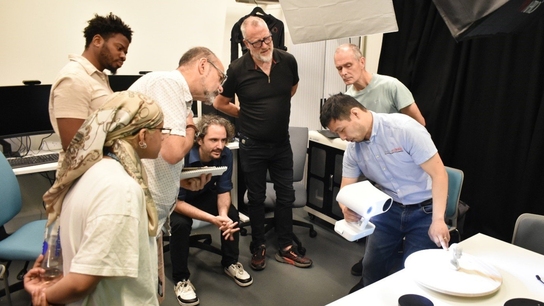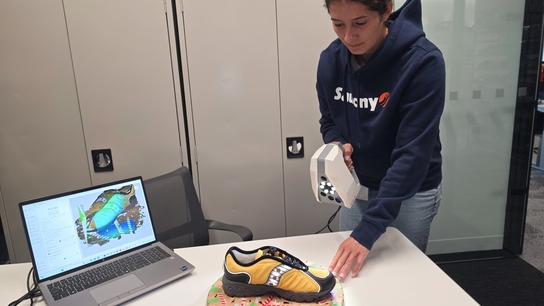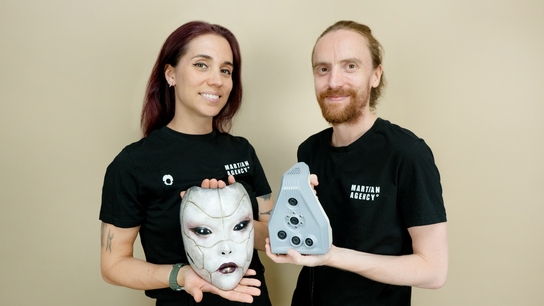Revealing the face of Robert the Bruce, King of Scots: using 3D scanning in forensics and archeology
The Goal: To perform 3D scanning both in the lab and out in the field, scanning living people as well as bones, skeletons, and bodies in various stages of decomposition.
Tools Used: Artec Spider, Artec Studio
Liverpool-based Face Lab uses Artec 3D scanning technology for forensic and archaeological research, installation art, and a new post-graduate program MA Art in Science.
Face Lab is a research group based at Liverpool School of Art and Design, Liverpool John Moores University. The group completes forensic and archaeological research as well as consultancy work for organizations such as the Police, national and international museums, and forensic institutes.
Using 3D scanning and other state-of-the-art technology, Face Lab carries out craniofacial analysis, which identifies unknown bodies in forensic investigation, or historical figures for archaeological depiction. The team produces facial images for forensic cases following the discovery of decomposed bodies and works collaboratively with archaeologists to find out how deceased people would have looked by reconstructing faces based on recovered skulls and historical evidence.
The research related to post-mortem decomposition, craniofacial reconstruction, ethics of display and facial animation is conducted at a highly specialized lab, which is equipped with the latest technology including 3D scanners and 3D printers, as well as 3D modeling, texturing, animation and haptic reconstruction software. Face Lab makes its research accessible through its public engagement activity and worldwide exhibition contribution.

Mark Roughley from Face Lab scanning a face at a recent public engagement event
Adding Artec Spider to the Face Lab toolkit
Face Lab approached Patrick Thorn & Co., Artec’s UK Gold Partner to purchase an Artec Spider high accuracy 3D scanner along with an Artec battery pack to replace their outdated handheld 3D scanner that had a poorer resolution and did not capture color.
“We had seen Patrick before when he was making a demonstration to another part of the University,” says Mark Roughley, Research and Teaching Assistant at Face Lab and the MA Art in Science Program.
When the order was placed, Patrick himself installed the Artec system and conducted a one-day comprehensive training course covering the capabilities of the scanner and Artec Studio 3D scanning and post-processing software.
“The easy-to-use Artec system is portable and accurate, both important things when using the scanner to capture human remains for 3D facial reconstruction, especially on site at locations across the world, where the Artec battery is essential,” says Mark.
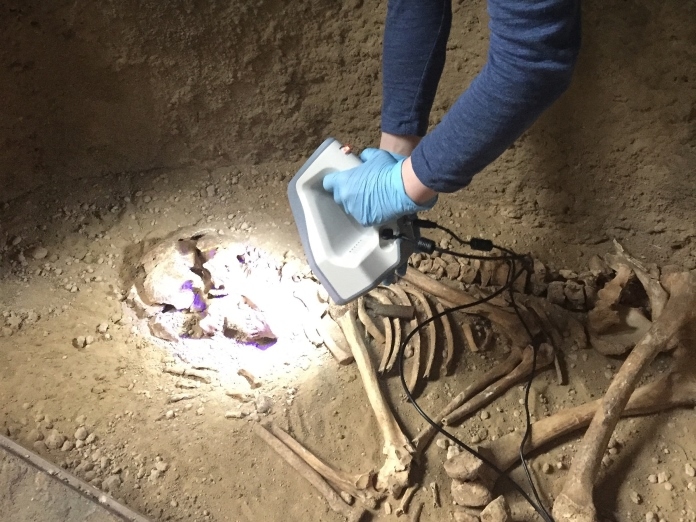
A member of the Face Lab team scanning the remains of ‘Liffs Low Man’ in situ in Buxton museum
The ability to capture color was very appealing to the Face Lab team and seen as highly beneficial for their research into facial animation, as having 3D faces that include photographic textures enables the team to produce more realistic facial animations. Face Lab is also creating a database of 3D faces and facial features such as ears, with photographic textures that can be used to add realistic skin to 3D archaeological depictions in 3D modeling software such as ZBrush.
Artec Spider allows for quick and accurate scanning of human skulls, which were difficult to 3D scan before. This capability is integral to Face Lab’s 3D workflow when producing facial depictions of people from the past.

A 3D scan of a face with photographic textures captured using the Artec Spider
Reconstructing the face of Robert the Bruce, King of Scots
Although Face Lab was only formed in 2014, researchers from the group have had huge success in their craniofacial analysis. The team’s most recent facial depiction of Robert the Bruce, King of Scots from 1306 to 1329, produced in collaboration with the University of Glasgow, began by 3D scanning one of the few casts of Robert’s skull, on loan from the Hunterian Museum in Scotland. This was the first step in order to start the 3D facial reconstruction process, using the haptic sculpting system utilized by the Face Lab team. The images of Robert the Bruce gained international publicity when released in December 2016 and featured in a BBC Alba documentary titled ‘Ceann an Righ.’

King Robert the Bruce: The stages of facial depiction. Image courtesy of Face Lab LJMU and University of Glasgow
Face Lab’s Artec Spider has now traveled across Europe and the UK to scan human remains. Its portability has allowed Face Lab to scan human remains in situ and within restricted museum collections. Some of the final facial depictions that began with a 3D scan from Spider can now be found in Bryggens Museum in Norway, Buxton Museum and Trinity College Dublin.
Scanning for installation art
Face Lab worked with bio-artist Gina Czarnecki and Professor John Hunt in 2015 through their ‘Heirloom’ project, which has since been exhibited around the world, most recently at FACT (Foundation for Art and Creative Technology) in Liverpool as part of their ‘No Such Thing as Gravity’ exhibition. Using Artec Spider, Face Lab 3D scanned the faces of Gina’s daughters with the artist’s intention to 3D print the faces in bio-glass and then to create 3D living portraits of the two daughters by growing cells collected from inside their mouths on the delicate glass faces.

Gina Czarnecki and Professor John Hunt ‘Heirloom’ 2017. Image courtesy of FACT
In 2016 Face Lab collaborated with Turner prize nominees, Jane and Louise Wilson on their ‘Undead Sun: We Put the World before You’ exhibition at MIMA (Middlesbrough Institute of Modern Art.) Face Lab scanned the artists’ faces (Jane and Louise happen to be identical twins) and using this 3D data, produced animations of their faces morphing into each other, leading to the creation of the average Jane/Louise face. This footage was included in their installation, alongside a 3D print of the generated average face which was disfigured with wounds symbolizing those inflicted on soldiers from WW1.

Jane and Louise Wilson ‘We Put the World before You’ 2016 still. Image courtesy of the artists.
Starting MA Art in Science postgraduate program at Liverpool School of Art and Design
Caroline Wilkinson, Mark Roughley and Kathryn Smith from the Face Lab team established a taught postgraduate program in 2016 at Liverpool School of Art and Design, titled MA Art in Science. The program is a unique opportunity for artists to collaborate in the fields of public health, astrophysics, sports science, technology, museum practice, computing, medicine and forensics. As part of the program, students are exposed to 3D practices in Face Lab and undergo training sessions with Artec Spider and software. Currently, two students are completing research projects utilizing the Artec solution.
“Since purchasing the solution, support from Patrick Thorn and Artec has been excellent,” says Mark. “We have had upgrades to the Artec Studio software that have made the whole scan to finished model so easy to do. The update that includes the Autopilot feature simplifies the processing even further – essential with students and all types of users.”
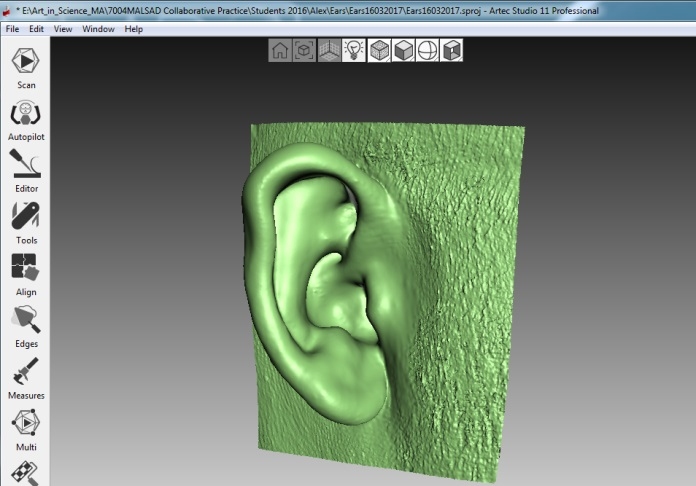
A 3D scan captured with Artec Spider as part of an MA Art in Science student project to create a database of 3D ear scans
“Artec Spider is allowing Face Lab and the MA Art in Science students to investigate new areas of Art/Science research and interact with artists and museums in new and interesting ways,” says Mark. “Working with Artec and Patrick Thorn has made this solution an easy to integrate and invaluable to part of our processes. When we need another scanner we would not hesitate to get in touch.”
Scanners behind the story
Try out the world's leading handheld 3D scanners.


